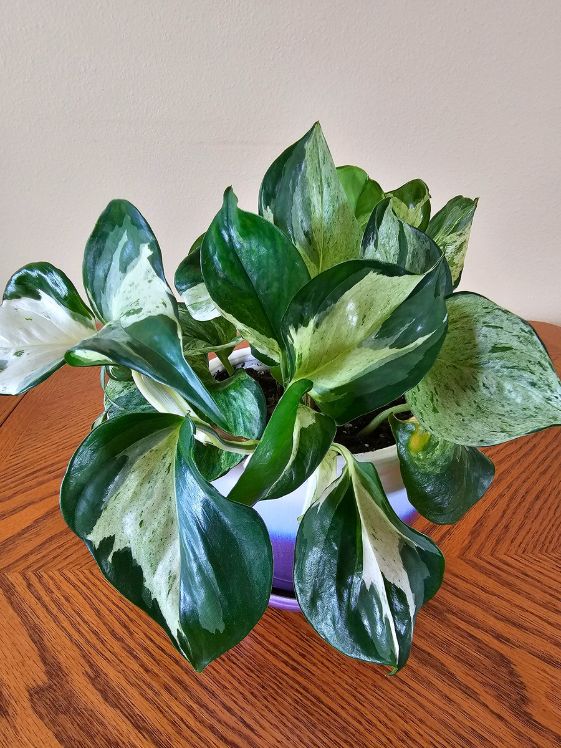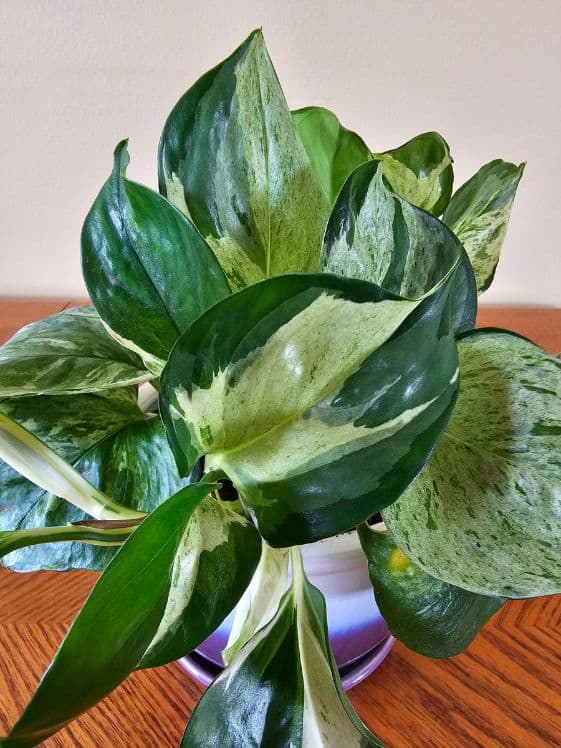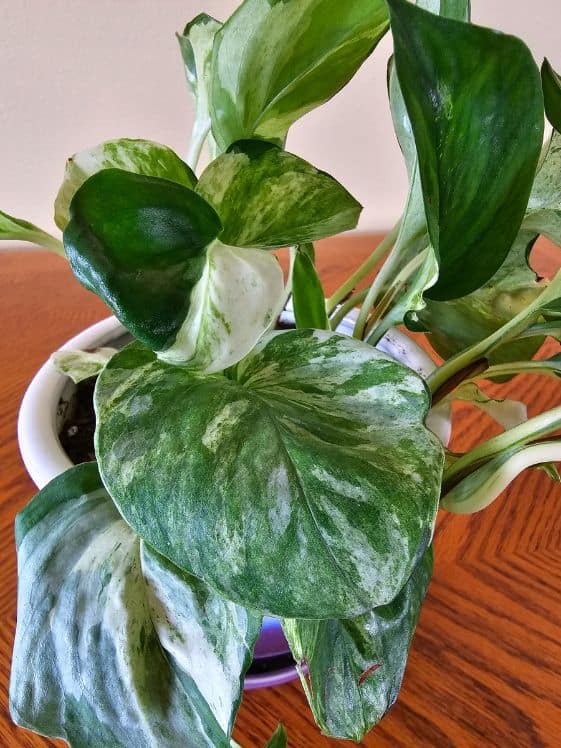Are you looking for a beautiful and easy-to-care-for houseplant to add to your collection? Consider the Manjula pothos! This stunning plant features heart-shaped variegated leaves with splashes of green, white, and cream, making it a standout addition to any room.
But how do you grow and care for a Manjula pothos? Luckily, this plant is relatively low-maintenance and can thrive in a variety of environments. With a few simple tips and tricks, you can keep your Manjula pothos healthy and happy for years to come.
In this article, we’ll cover everything you need to know about growing and caring for a manjula pothos, from the best soil and lighting conditions to watering and fertilizing tips. Whether you’re a seasoned plant parent or a beginner looking to add some greenery to your space, you’ll find everything you need to know right here.
This post may contain affiliate links. That means if you click on them and buy something, I may receive a small commission. Read my Disclaimer Policy to learn more. As an Amazon Associate, I earn from qualifying purchases.
What is a Manjula Pothos?

The Manjula Pothos is a beautiful variety of variegated pothos that belongs to the Epipremnum genus in the Araceae family. This pothos cultivar is known for its striking, heart-shaped leaves and vibrant coloration.
Its leaves showcase an incredible mix of color, with cream, white, and green tones that create a stunning visual appeal. As this pothos matures, its trailing vines can grow quite long, making it an ideal choice for indoor hanging baskets or as a feature plant in your home.
Since Manjula Pothos thrives in various light conditions and can be easily propagated, it’s a versatile and adaptable option for plant collectors and beginners alike.
Is Manjula Pothos Rare?
The Manjula pothos (Epipremnum aureum ‘Manjula’) is rarer than some varieties of pothos, like the golden pothos, but it isn’t as rare as it used to be.
Just a few years ago you could hardly find it in any of the smaller nurseries and garden centers. And you would have never found it in a Walmart.
Now you can find it at various times in any of those stores. I actually found the one I have at my local Walmart.
While it is still harder to find than some plants, it is definitely less rare than it used to be.
Are Manjula pothos poisonous/toxic?
Like other pothos plants, the Manjula pothos is toxic to humans and pets. The calcium oxalate crystals in the plant’s leaves and stems can cause painful irritation to the mouth and throat if ingested. It can also cause swelling of the lips, tongue, and throat and gastrointestinal problems.
Manjula pothos should be kept out of the reach of pets and small children.
Manjula Pothos Care

Since Manjula pothos is a hardy plant, it doesn’t require much special care. However, there are some basic requirements to keep in mind when growing your own.
Lighting
Manjula Pothos thrive in bright, indirect light. However, they can tolerate lower low light conditions as well, though too low of light can cause the plant to become leggy.
Avoid placing your plant in direct sunlight, as this can cause scorching and damage to the leaves.
Watering
Water your Manjula Pothos when the top inch of the soil feels dry. Be careful not to overwater, as this can lead to root rot. In general, you might need to water your plant every 7-10 days, depending on the environment it’s in.
Humidity
Manjula Pothos can tolerate a range of humidity levels, but they prefer moderate to high humidity. To maintain humidity, you can place your plant on a tray with pebbles and water.
You can also increase the humidity around your manjula pothos by grouping several plants together.
Another option is using a small humidifier near your Manjula. But I have found that unnecessary even during the cold, dry midwest winters.
As long as I make sure to properly water it, it seems to do just fine with lower humidity during the winter (though I do have it grouped with multiple other plants year-round, mainly to save space.
Temperature
The ideal temperature range for Manjula pothos is between 65°F and 80°F (18°C to 27°C). While this is the ideal range it can tolerate some variation in temperature.
Manjula pothos are not cold tolerant and temperatures below 45 to 50°F (7°C to 10°C) can cause significant damage to the plant or even kill the plant.
Soil
For optimal Manjula pothos care, use a well-draining potting mix. I like Miracle Grow but any good quality potting mix will work for this pothos plant.
Just make sure to avoid the potting mixes that feel extra heavy compared to other bags of the same size. Those ones never seem to do as well as the lighter bags.
Fertilizing
While Manjula pothos is a hardy plant, it still requires some fertilization to stay healthy and grow.
During the growing season, it’s recommended to fertilize the plant once a month. The growing season is typically thought to be spring and summer, but when artificial lights are used, the plant may continue growing throughout the year.
If your plant is actively growing, it may need some fertilizer throughout the year. Just make sure to follow the directions on the fertilizer that you choose.
To promote the healthy growth of houseplants, it is crucial to opt for a balanced fertilizer that is specifically designed for them. Such a fertilizer will contain all the essential nutrients that the plant requires.
Pruning your plant
Prune your Manjula Pothos to encourage bushier growth and maintain its shape. Remove any yellow or damaged leaves, and trim back long stems as needed. You can also propagate the cuttings.
Repotting
Manjula Pothos are efficient at adapting to cramped spaces, so repotting is often not needed until the plant starts to become root bound.
When repotting, choose a pot one size bigger than the current pot. You want one with drainage holes to prevent waterlogging and use a well-draining potting mix to ensure healthy root development.
Propagating Manjula Pothos
Stem cuttings are the easiest way to propagate a manjula pothos. Begin by choosing a healthy stem that has at least two nodes (the spot where the leaf comes out of the stem).
Cut the stem directly below the leaf node as this is where new roots will form. Remove the bottom-most leaf from the cutting.
Place the exposed stem in a jar of water, ensuring that the node is submerged. The water can be changed every few days but I personally only change it if it starts to look cloudy. If you don’t change the water, make sure to add fresh water as needed to ensure the submerged node stays underwater.
Keep the container in a warm area and avoid direct sunlight, as this may damage the cuttings. After a week or so, you should notice roots forming from the submerged nodes, though this can take longer for some cuttings.
Wait until the roots are approximately 2 inches long before considering potting your new Manjula Pothos plant.
Prepare a well-draining potting mix and a suitable pot with drainage holes to prevent root rot. Gently plant the cutting, keeping the roots moist during the process. Once potted, place your new Manjula Pothos in a bright area with indirect light and maintain consistent humidity levels.
Monitor the potting mix’s moisture and avoid overwatering.
How Fast Does Manjula Pothos Grow?

Manjula pothos are known to be slower-growing compared to other pothos varieties, such as the classic golden pothos. Under optimal conditions, your indoor Manjula pothos can typically grow up to six feet in length, though outdoors it can grow much larger.
Common Problems with Manjula Pothos
Manjula Pothos are usually very hardy and easy to look after, but here are some common problems you may come across:
Brown Tips
One issue you might encounter with your Manjula Pothos is brown tips on the leaves. These can be caused by several factors, including:
- Low humidity: A common reason for brown leaf tips is low humidity. To increase humidity around your plant, you can place a tray of water near it or use a humidifier.
- Too much fertilizer: Fertilizing too much (either too often or using too much at one time) can cause brown tips.
- Watering issues: Both overwatering and underwatering can cause brown tips on a Manjula pothos. Make sure to water your plant when the topsoil feels dry, but be careful not to overwater.
Leggy Growth
A Manjula pothos that develops leggy growth is one where the space between leaves is larger than normal. This usually happens when the plant is not getting enough light.
Move it to a brighter location and the new growth should become less leggy. Unfortunately, there is no way to make the plant fill in the older growth.
If you don’t like how the legginess looks, you can prune the plant back to before the leggy growth. As long as the plant is now in a brighter location the new growth should be less leggy.
Drooping Leaves
The main cause of drooping leaves on a Manjula pothos is a watering issue. This can be either from overwatering or underwatering.
To determine if you are over or under-watering, you need to check the plant. Just stick your finger in the soil to about the first knuckle.
If all you feel is dry soil, your plant is too dry and needs watering now and should be checked more frequently. If the soil is damp or wet you could be overwatering. Wait another couple of days and check again.
Common pests
One common issue you may encounter when caring for your Manjula pothos is pests. A few well-known pests that often infest these plants are mealybugs, spider mites, and fungus gnats. It’s essential to keep an eye out for these nuisances, as they can damage your plant and hinder its growth.
Mealybugs tend to appear as tiny, white, cotton-like masses on your Manjula pothos. These pests can cause leaf yellowing, leaf drop, and a general decline in plant health.
Spider mites, on the other hand, are microscopic arachnids that can cause webbing on the plant and discoloration, leading to leaf loss.
Lastly, fungus gnats are tiny flying insects that are more annoying to humans than damaging to plants. Their larvae do eat decaying material and if left alone can eventually cause damage to the roots of the plant (though you are more likely to be driven crazy by them before they do any damage).
Regularly inspecting your plant can help you catch an infestation early making treatment easier and more successful.
With proper attention and care, you can keep your Manjula pothos healthy and thriving.
Related posts
27 Types of Pothos to Grow in Your Home
N’Joy Pothos Care: Tips for Growing and Maintaining a Healthy Plant

